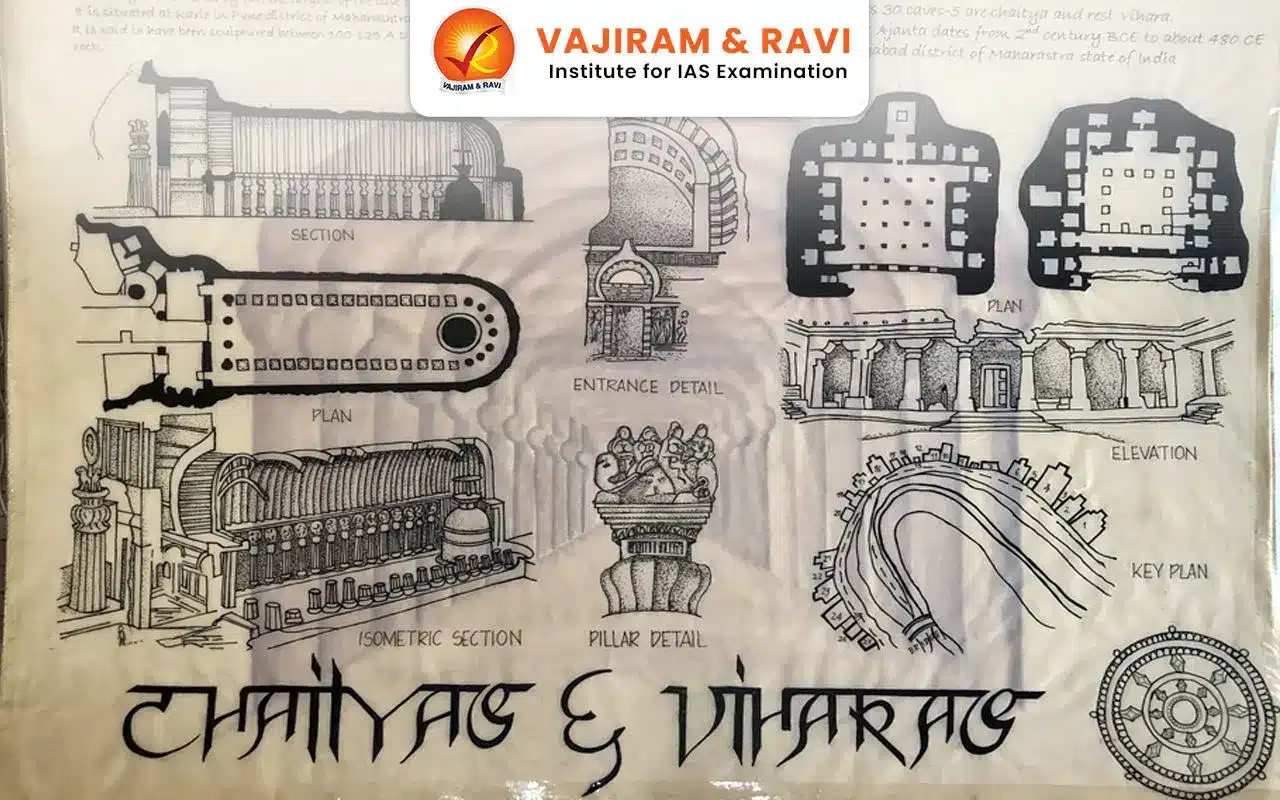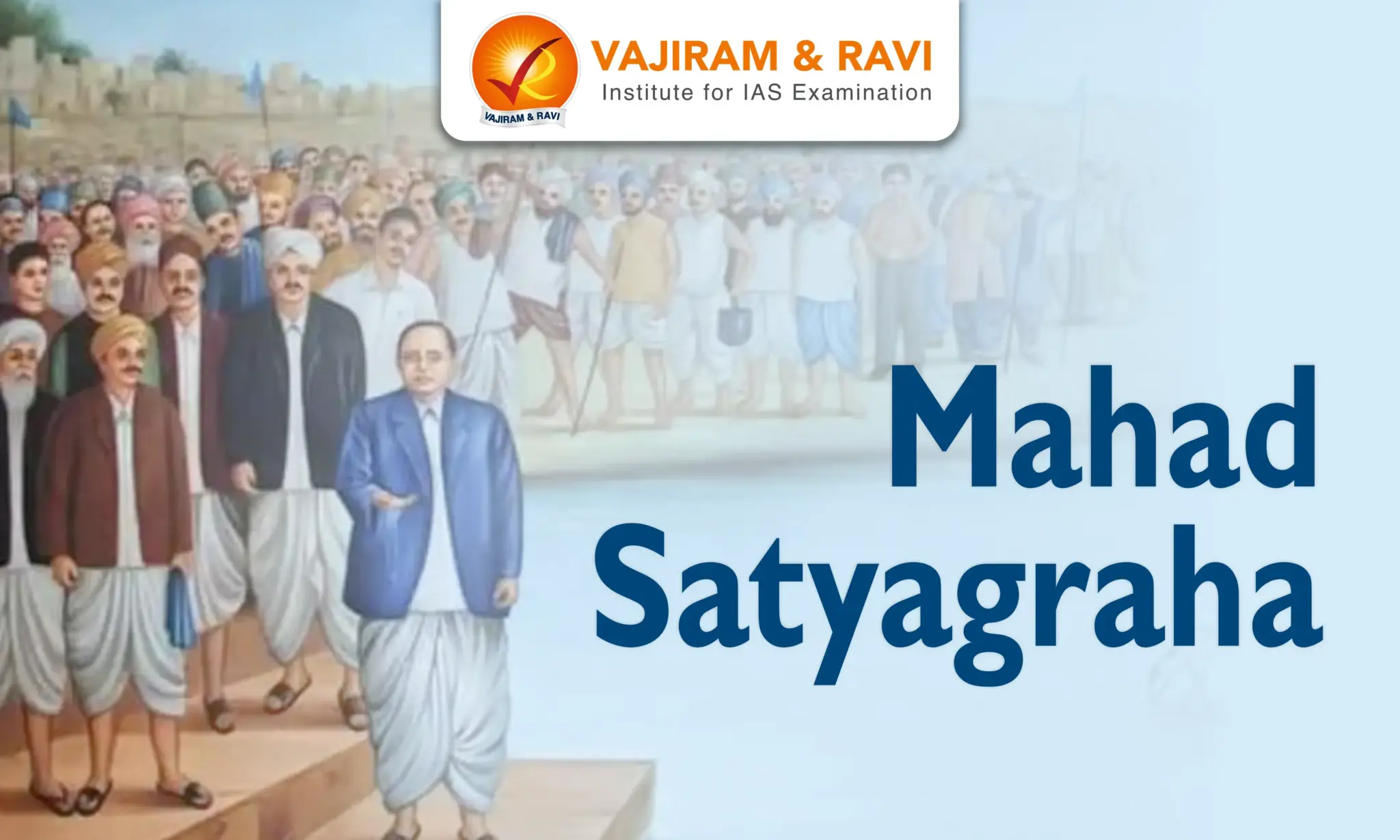Viharas and Viharas Chaityas are two major types of Buddhist rock-cut architecture that played a significant role in the spread and development of Buddhism in ancient India. Viharas served as monasteries housing monks for spiritual learning and meditation, while Chaityas were sacred assembly halls for congregational worship. These structures were strategically located near trade routes, allowing monks to access food donations from visiting traders. The construction of Viharas and Chaityas saw patronage from wealthy merchants and rulers like Ashoka, who commissioned many such structures. Interiors of Viharas and Chaityas were decorated with exquisite mural paintings conveying religious themes executed with the finesse of lines, expressions and colours.
Viharas
Archaeological evidence shows early viharas were constructed using transient materials like wood and sun-dried bricks—these structures date before the third century BCE, or the Mauryan period.
- Architectural features of Viharas: The generic architectural layout plan for Viharas excavated within caves consists of:
- Cell layout: Monks used to live in a few cells surrounding the central hall for worship in the rock-cut vihara.
- Entrance and Verandah: A pillared verandah and a doorway carved out of rock lead to the square or rectangular hall.
- Stone beds: There were stone beds in the cells or rooms without windows, formed from the natural rock.
- Hinayanist viharas: Majorly found in the Western Ghats, like Ajanta, Ellora, Bedsa, Kondane, Pitalkhora, and Nasik.
- The highly decorated facades as well as sculptural panels and friezes are the remarkable elements of these viharas.
- Mahayanists viharas: Ajanta, Ellora, etc. contain these viharas also.
- At times, the Mahayanists transformed the vihara, which was exclusively a residential place, into a place of worship, that is, a chaitya-griha-cum-vihara.
- Instead of a stupa, the image of the Buddha carved on the body of the stupa became the object of worship in these viharas.
- Plan of Maha Vihara: Mahavihara is a monastic complex of several viharas.
- Emerging during the Gupta era, mahaviharas could host thousands of monks for spiritual learning.
- They played a crucial role in disseminating Buddhist teachings.
- They were centres for scriptural studies, philosophical debates, and intellectual exchange.
- With Pala dynasty support, notable Mahaviharas like Nalanda reached their peak influence.
- Notable Mahaviharas were: Taxila, Vikramashila, Valabhi, Odantapuri and Somapura.

Chaityas
Chaityas were specifically designed as places of worship for Buddhist monks and devotees. Unlike residential Viharas, Chaityas served as sacred assembly halls with religious ceremonies and reverence. The term "chaitya" encompasses various objects deserving of worship, including stupas, Bodhi trees, Buddha images, and Bodhisattva representations.
- Architectural layout: The architectural plan for Chaityas is very simple.
- It typically consists of a single, long hall with a barrel-vaulted roof that gives the impression that it is semi-cylindrical. Like the back of an elephant, its end is apsidal.
- Stupa placement: With its rock carving, the stupa was placed in the apse(angle) with ample room for pradakshina, or circumambulation.
- Hinayana Chaityas: Bhaja, Kondane, Bedsa, Karle, Pitalkhora, Pandulena at Nasik and few caves at Ajanta.
- Buddha is represented only through symbols in these chaityas. These symbols include the life of Buddha himself, like stupa, Vajrasana, Bodhi Tree, etc.
- Another group of symbols was called "tri-ratna," which stands for the three tenets of the Buddha: Dharma, Buddha, and Sangha.
- The exteriors of Chaitya-grihas depict human and animal forms in addition to partially divine creatures, such as Yakshis and Yakshas.
- Buddha is represented only through symbols in these chaityas. These symbols include the life of Buddha himself, like stupa, Vajrasana, Bodhi Tree, etc.
- Mahayana Chaityas: Karle and Kanheri in Maharashtra (added Budhha’s image), a few caves at Ajanta, Vishwakarma cave at Ellora, the main Hinayanist rock-cut caves are at Bhaja, Kondane, etc.
- The Mahayanist chaityas are extensively adorned with ornamental features and sculptures based upon new mythologies that emerged in the Mahayana literature.

Major Chaityas and Viharas in India
| Site | Key Description |
|
Karle Chaitya |
- Period: 160 BCE - 5th CE - Ancient Buddhist rock-cut cave complex near Lonavala, Maharashtra. - It has the largest Chaitya hall, animal and human engravings on pillars and 3 decorated viharas. - Earlier a Hinayanist chaitya, later Buddha's images were added.
|
|
Nasik Chaitya |
- Period: Satavahana. - A group of 16 viharas and 1 chaitya situated in Nasik, Maharashtra called ‘Pandulane’. - It also featured a musical/dance hall. |
|
Junnar Vihara |
- An ancient Buddhist cave (Lenyadri caves) in Junnar, Maharashtra is known as ‘Ganeshleni’. - Later converted into the Chaitya-Vihara complex. |
|
Bhaja Chaitya |
- Period: 2nd Century BCE - Buddhist cave network near Pune with 22 rock-cut caves situated along the key trade route. |
|
Konkade Vihara |
- The Unique Buddhist monastery in Colaba, Mumbai. - Rare instances of Buddhist structures made completely of wood rather than stone. |
|
Pitalkhora Chaitya |
Period: 3rd Century BCE - Site with 14 cave shrines on Satmala Hills constructed by ancient guilds as per inscriptions. Houses chaitya with relics.
|
|
Bedsa Chaitya |
- Located south of Karle Chaitya, displays the transition from wooden architecture to stone.
|
|
Kanheri Vihara |
- Extensive cave complex within Sanjay Gandhi National Park near Mumbai with Buddhist carvings & paintings dating from the 1st Century BCE to the 10th Century CE. |
Mahaviharas
| Site | Key Description |
|
Nalanda Mahavihara  |
Period: 3rd-13th CE Located in Bihar, it was a major centre of Buddhist learning and a significant monastery. - Founded by the Kumaragupta, expanded by the Pala dynasty. |
|
Vikramashila Mahavihara  |
- Period: 8th-12th CE - Located in Bhagalpur district, Bihar, it was a prominent Buddhist university and monastery. - Founded by Pala King Dharmapala. |
|
Somapura Mahavihara  |
- Period: 8th-12th CE - Located in Paharpur, Bangladesh, it was a major Buddhist monastery and centre of learning. - Founded by Pala King Dharmapala. |
|
Odantapuri Mahavihara  |
- Period: 7th-12th CE - Located in Bihar, it was a significant Buddhist monastery and seat of learning. - Founded by King Gopala of the Pala dynasty. |
|
Jagaddala Mahavihara  |
- Period: 8th-12th CE - Located in Naogaon, Bangladesh, it was a significant Buddhist monastery and seat of learning for the study and dissemination of Tantric Buddhism. - Founded by the Ramapala, Pala dynasty. |
Viharas and Chaityas UPSC PYQs
Question 1: Some Buddhist rock-cut caves are called Chaityas, while others are called Viharas. What is the difference between the two? (UPSC Prelims 2013)
- Vihara is a place of worship, while Chaitya is the dwelling place of the monks
- Chaitya is a place of worship, while Vihara is the dwelling place of the monks
- Chaitya is the stupa at the far end of the cave, while Vihara is the hall axial to it
- Vihara is a cave constructed on the bottom of the hill and Chaitya is a cave constructed on top of the hill.
Answer: (b)
Last updated on December, 2025
→ Check out the latest UPSC Syllabus 2026 here.
→ Join Vajiram & Ravi’s Interview Guidance Programme for expert help to crack your final UPSC stage.
→ UPSC Mains Result 2025 is now out.
→ UPSC Notification 2026 is scheduled to be released on January 14, 2026.
→ UPSC Calendar 2026 is released on 15th May, 2025.
→ The UPSC Vacancy 2025 were released 1129, out of which 979 were for UPSC CSE and remaining 150 are for UPSC IFoS.
→ UPSC Prelims 2026 will be conducted on 24th May, 2026 & UPSC Mains 2026 will be conducted on 21st August 2026.
→ The UPSC Selection Process is of 3 stages-Prelims, Mains and Interview.
→ UPSC Result 2024 is released with latest UPSC Marksheet 2024. Check Now!
→ UPSC Prelims Result 2025 is out now for the CSE held on 25 May 2025.
→ UPSC Toppers List 2024 is released now. Shakti Dubey is UPSC AIR 1 2024 Topper.
→ UPSC Prelims Question Paper 2025 and Unofficial Prelims Answer Key 2025 are available now.
→ UPSC Mains Question Paper 2025 is out for Essay, GS 1, 2, 3 & GS 4.
→ UPSC Mains Indian Language Question Paper 2025 is now out.
→ UPSC Mains Optional Question Paper 2025 is now out.
→ Also check Best IAS Coaching in Delhi
the Viharas and Chaityas FAQs
Q1. How are Viharas different from Chaityas?+
Q2. What are the typical architectural elements of a Chaitya?+
Q3. Where have most rock-cut Viharas and Chaityas been excavated from in India?+
Q4. How are Viharas and Chaityas architecturally different from structural temples?+
Q5. What was the historical significance of Viharas and Chaityas?+
Tags: quest viharas and chaityas

























